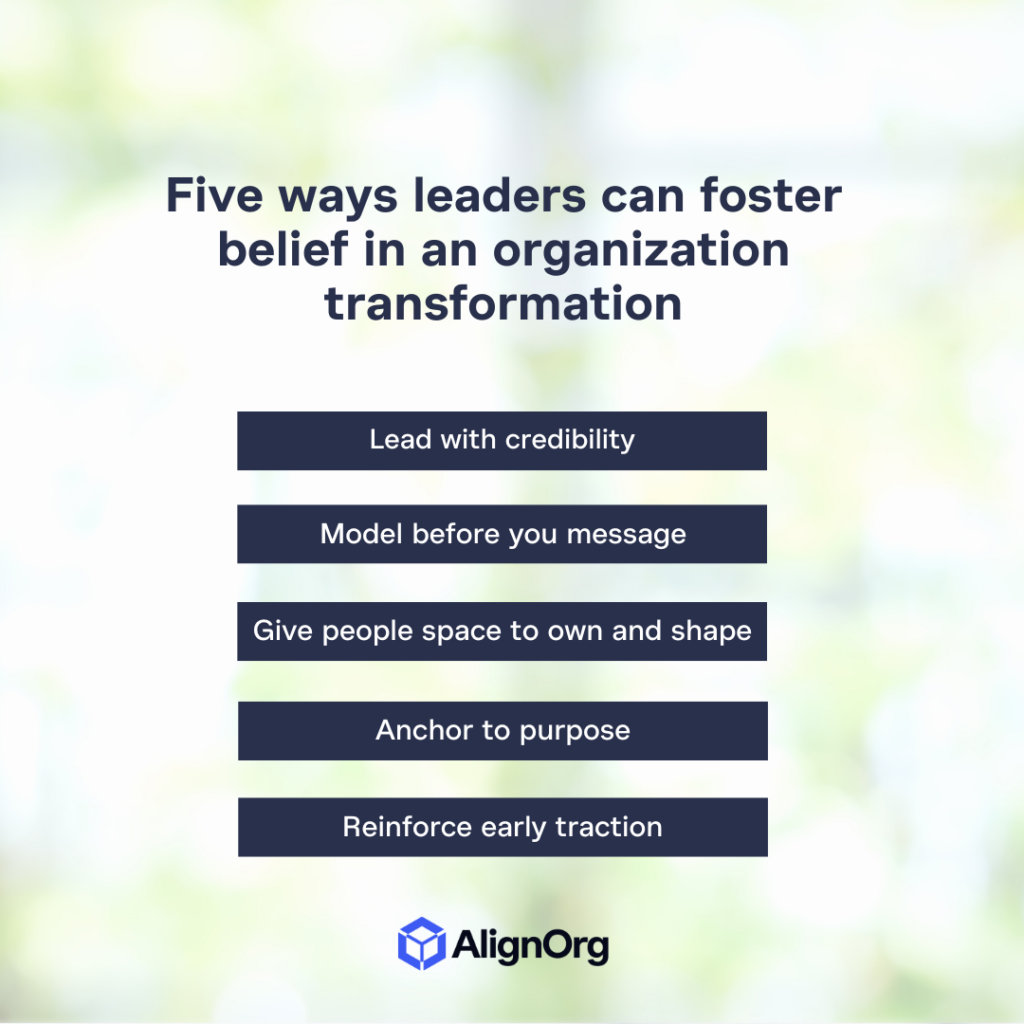Years ago, I was in the middle of a major transformation at a company I cared deeply about. New strategy. New structure. All the signs that something important was underway.
I remember sitting in a meeting shortly after the announcement, trying to make sense of what it all meant. I wasn’t overly concerned about my own role but I was proud of what the company stood for, and I didn’t want that to get lost.
I understood that leadership couldn’t share every detail. And in hindsight, I suspect they didn’t have all the answers yet either. That’s just the reality of complex change.
So I found myself asking a different kind of question:
“Do I believe what I’m hearing aligns with who we are? Does it reflect our values? Is this something our leaders are truly committed to? Is it something I want to be a part of?
And I realized: the answers weren’t going to come from the next formal communication. They would come from watching the leaders around me.
Not just what they said, but how they behaved. How they showed up in meetings. Whether they asked different questions. Whether they created clarity or waited for someone else to provide it. Those everyday signals told me more than any formal update.
And when I began to see leaders step into the ambiguity, lean into the change and bring their teams along…that’s when I started to believe the transformation might actually work.
That moment has stayed with me ever since because it taught me something important:
Transformation is powered by belief.
Belief Isn’t Mandated, It’s Earned
In any transformation, there’s a point when people stop asking, “What’s changing?” and start quietly asking themselves, “What does this mean for me?”
That’s the moment William Bridges (developer of the Bridges Transition Model) describes so clearly: before people can embrace the new beginning, they have to navigate what’s ending and what might be lost along the way. Even when the strategy makes perfect sense, individuals are still sorting through their own experience of change: identity, relationships, ways of working, unspoken norms.
Belief isn’t triggered by messaging. It’s shaped by what people see in the actions around them.
It begins to take shape when people:
- See that the things they value won’t be forgotten
- Start to feel a sense of clarity, even if it’s not certainty
- Notice new behaviors emerging
- Find moments where they feel included and trusted to help shape what comes next
The tipping point is often quiet. But once someone starts to see that this change might help them grow, not just cost them something, they begin to lean in.
That’s when belief starts to build.
The Change Agents We Often Overlook
When people are navigating uncertainty, they don’t always look to the top for answers. They look around them, to the leaders they interact with every day. To the behaviors that feel authentic, grounded and real.
I’ve seen this play out time and again. During moments of change, belief rarely stems from the corporate announcement or the executive video. It comes from the people nearby who help make sense of the ambiguity; who interpret, adjust, model and bring others along.
That’s why mid-level leaders matter so much. They’re close enough to the work to understand its realities, and close enough to their teams to build trust through consistency.
And it’s not just anecdotal. According to Edelman’s Trust Barometer, employees are twice as likely to trust someone like themselves, often a direct or mid-level leader, over a CEO when it comes to company information.
In transformation, trust doesn’t just flow down from the top. It can also travel laterally through relationships and shared context.
Why I Started Paying Attention to the Middle
Middle managers sit in one of the most demanding positions during transformation. They’re expected to interpret strategy, sustain performance, reassure teams and adopt new ways of working all at the same time.
They’re close enough to feel the friction and far enough from decision-making to be left out of the “why.” And yet, they’re the ones employees look to most when deciding whether to lean in or lay low.
Here’s what often gets overlooked:
- They’re expected to lead before they’ve had time to process. Just because they attend the rollout doesn’t mean they’ve internalized the change. They need space to reflect, make sense of it and translate it before they’re expected to lead others through it.
- They receive mixed messages about what matters. Senior leaders speak about transformation, but the performance system continues to reward short-term delivery. Managers are stuck navigating two playbooks: one for change and one for today’s results.
- They’re navigating ambiguity with limited support. New roles, shifting processes and fuzzy decision rights create uncertainty. Middle managers are left to interpret the gaps, often without the tools or context to do so confidently.
Despite all this, they’re the ones holding the line; translating strategy into action, shaping how change is experienced on the ground and determining whether belief actually takes root.
If you’re serious about making change stick, don’t just include middle managers—equip them, invest in them, and give them permission to lead through uncertainty.
This Is Where Leaders Make the Difference
You can’t mandate belief. You can’t program it into a roadmap. But you can create the conditions for it to take hold.
Belief builds slowly, and often sideways. Through conversations, observations, and the accumulation of lived experience. Especially when mid-level leaders are equipped to lead in the ambiguity, not just execute from behind it.
Here’s what supports belief in practice:
- Lead with credibility. Make early actions align with the promise of the change.
- Model before you message. People listen to what leaders say, but they believe what leaders do.
- Give people space to own and shape. Involve those closest to the work in defining how change comes to life.
- Anchor to purpose. Don’t just explain what’s changing, connect it to what matters most.
- Spot and reinforce early traction. Celebrate the signs that new behaviors are emerging. That’s how trust spreads.
At AlignOrg, we approach change as something leaders enable, not something they push. We help organizations create the structures, messages and behaviors that turn strategic intent into shared commitment. When leaders are aligned and empowered to model the change, execution becomes energized and sustainable.

Belief Is the Inflection Point
Design sets the direction. Governance builds the scaffolding. Communication creates awareness.
But belief is what gives transformation its momentum.
When people believe:
- They stay engaged when things get hard
- They act with intention
- They help others make sense of the change
- They take ownership
Belief isn’t loud. It doesn’t show up in launch plans or executive dashboards. But it’s there—in the way people show up, speak up and step forward.
If you’re leading a transformation, watch for the moment someone around you shifts from asking “why?” to “what’s next?”
That’s the signal.
That’s when transformation begins to take hold.





